Students become teachers as academy welcomes Pontiac youth organization
Week 21: Dec. 3-9, 2017
Sensing the shyness of their young guests, recruits ambled to the table at which two teens were seated. “So, where are you from?” one recruit asked, hoping to break the ice and spark a conversation. The exchange continued for a while as 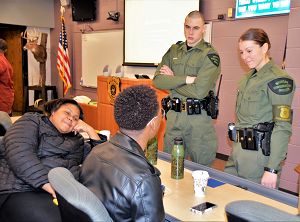 recruits and visitors searched for common ground. When the topic turned to music, the guests were surprised to find out that some of the recruits enjoy the same types as they do. recruits and visitors searched for common ground. When the topic turned to music, the guests were surprised to find out that some of the recruits enjoy the same types as they do.
Bingo! Before long, small talk gave way to smiles, and smiles became laughter.
The scene was repeated throughout the room as other recruits went out of their way to make the guests feel at home, showing them natural resources displays and answering questions about animals, nature, hunting safety and the job of a conservation officer.
The visitors, students in the Pontiac-based Take 1 Community Program, were spending the day at the Michigan Department of Natural Resources Conservation Officer Recruit School. It was a chance for them to further develop their interests in natural resources, but the students weren’t the only ones benefiting from the experience. After 21 weeks in the academy, recruits welcomed the opportunity to step out of their roles as pupils and become teachers and mentors to their young guests.
It’s a role they’ll need to be comfortable with because conservation officers do more than enforce the law. They also are educators who spend hundreds of hours each year with school students, community organizations and stakeholder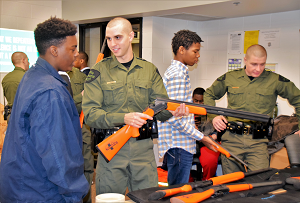 groups, sharing their experiences as well as their knowledge of natural resources, outdoor safety and the law. Conservation officers are perhaps the most recognized symbol of the DNR, and recruits will be expected to interact with the public and make educational presentations to various groups throughout their careers. groups, sharing their experiences as well as their knowledge of natural resources, outdoor safety and the law. Conservation officers are perhaps the most recognized symbol of the DNR, and recruits will be expected to interact with the public and make educational presentations to various groups throughout their careers.
Small game, big job
Recruits launched into Week 21 by enhancing their knowledge of small game. The classroom was filled with specimens that included pheasants, squirrels, rabbits, songbirds and weasels. Sgt. Bobbi Lively, an area law supervisor with the DNR Law Enforcement Division’s District 5, explained the role that small-game enforcement plays in a conservation officer’s daily duties.
Many people think only of deer and fish law enforcement when they think of conservation officers. In reality, small-game enforcement is a large part of an officer’s day-to-day 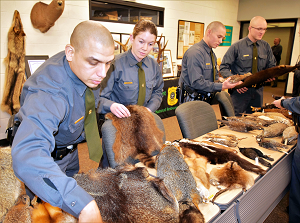 responsibilities. Conservation officers must be proficient in identifying small-game species and in knowing the laws that protect these resources. responsibilities. Conservation officers must be proficient in identifying small-game species and in knowing the laws that protect these resources.
Sgt. Lively also discussed basic concepts of wildlife management. “A wildlife manager’s job is to maintain the number of animals in a habitat at or below its carrying capacity, so no damage is done to the animal or habitat,” she said. “This is done by monitoring birth and death rates of various species and the condition of their habitat. The data is used to set hunting regulations and determine if other management practices are needed to conserve the species.”
Following the presentation, Sgt. Lively formed recruits into groups so they could practice identifying various species while also learning the hunting and trapping regulations that govern their harvest.
Test time
Good thing recruits took Monday’s training to heart, because Tuesday morning brought a final practical exam on small-game identification. The class had to identify 23 species, as well as know the season dates and bag limits for each.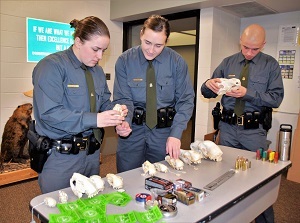
Sgt. Lively then moved the class on to animal skull identification. Conservation officers frequently respond to calls from citizens who find animal carcasses. However, not every call that an officer responds to will be about a recent animal death. After winter thaw, it is common for conservation officers to respond to carcass complaints where the animal died the previous fall. Officers must know the difference between a coyote, wolf and bear skull. It’s also not uncommon for officers to come across a furbearing animal that has been skinned. They must be able to tell the difference between animal species even if the fur has been removed.
Firearm facts
The rest of Tuesday morning was spent going over firearm and ammunition familiarization. Recruits had the opportunity to handle nonfiring training firearms used in hunter safety programs. The firearms had various types of actions, including break-action, pump-action, lever-action, bolt-action and semi-automatic. When recruits reach the field, they will handle all types of firearms while checking the compliance of hunters. They will have to recognize and be comfortable handling whatever type of firearm they come across.
Tuesday afternoon was capped off with training in citation writing. Sgt. Lively gave recruits a set of circumstances in which they had to look up laws and decide what type of enforcement action to take. With graduation just two weeks away, recruits soon will be making these decisions in real life.
Wildlife investigation
Conservation Officer Richard Stowe introduced the class to wildlife investigation methods Wednesday morning. Officer Stowe explained the basics and stressed the importance of gathering as much information from the complainant as possible.
He also emphasized the importance of responding to an investigation with the proper equipment. Whether it is a camera, GPS, range finder, flashlight or other key piece of gear, conservation officers must be prepared to hike into complaint areas and gather evidence.
Officer Stowe reminded recruits that making multiple trips to and from a patrol truck can disturb a crime scene. He 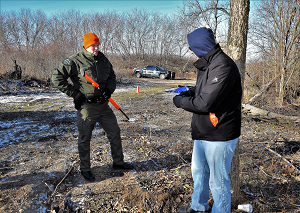 then stressed the importance of being observant and having attention to detail, which are traits that have been instilled in recruits since their arrival at the academy. Now that they are preparing to enter the field, these lessons are coming full circle. then stressed the importance of being observant and having attention to detail, which are traits that have been instilled in recruits since their arrival at the academy. Now that they are preparing to enter the field, these lessons are coming full circle.
Let’s talk turkey
Michigan has spring and fall turkey seasons, and Conservation Officer Troy Van Gelderen walked recruits through wild turkey enforcement. Turkey hunters are not required to wear “hunter orange” clothing, which elevates the risk of accidents if people hunt unethically. The uniqueness of turkey hunting makes it important for recruits to understand the various enforcement methods involved.
Big-game enforcement
Recruits rejoined Officer Stowe in the afternoon for instruction on elk law enforcement. All recruits assigned to the northern Lower Peninsula will work elk season. In some counties, calls regarding elk come into the DNR year-round. Officer Stowe secured a deceased cow elk that was struck by a car, which allowed recruits to practice a necropsy – or an animal autopsy – on it to determine the cause of death. Conservation officers perform necropsies on big and small game when investigating a potential poaching case.
The big-game theme continued into Thursday under the direction of Sgt. Marc Pomroy, area supervisor of the U.P. counties of Dickinson, Gogebic and Iron. Sgt. Pomroy explained the enforcement of bear, wolf and moose laws. While 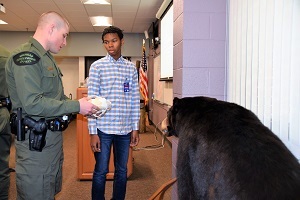 bear season is very active in the western U.P., Michigan does not have hunting seasons for wolf or moose. However, conservation officers respond to all reports regarding deceased wolves and moose, as both priority species take precedent in death investigations. bear season is very active in the western U.P., Michigan does not have hunting seasons for wolf or moose. However, conservation officers respond to all reports regarding deceased wolves and moose, as both priority species take precedent in death investigations.
This also was the day recruits played host to students and administrators of the Take 1 Community Program. The program promotes leadership and recreation for youths in the metropolitan Detroit region. The DNR and its conservation officers are committed to doing what they can to expose urban youths to Michigan’s natural resources. Providing these experiences broadens the public’s understanding of the importance of our natural resources, and raises awareness of career opportunities in the natural resources field.
The visit was a hit with recruits and their guests. Not only did the students appreciate recruits’ perspectives on how to accomplish goals, but at least three of the visitors were so impressed by the experience that they are interested in pursuing conservation officer careers.
Putting it into practice
The class went through final scenarios Friday. Volunteers acted as hunters in five scenarios involving crow, coyote,  deer, pheasant and turkey hunting. Recruits approached the sportsmen and sportswomen, checked their licenses and issued citations if appropriate, just as they will do after graduation. It once again was a great chance for recruits to apply what they learned in a controlled environment before they enter field training. deer, pheasant and turkey hunting. Recruits approached the sportsmen and sportswomen, checked their licenses and issued citations if appropriate, just as they will do after graduation. It once again was a great chance for recruits to apply what they learned in a controlled environment before they enter field training.
Confident and ready
With just under two weeks to go before graduation, recruits are brimming with confidence and enthusiasm. And why not? For 21 weeks they’ve passed every test and overcome every challenge. This week, they even shed their trainee uniforms and began sporting the actual Class C uniform of a conservation officer. But they also know losing their focus at this point would be risky. After all, the academy’s trials won’t stop until recruits get those coveted gold badges pinned to their chests on graduation day.
Subscribe to the weekly conservation officer academy blog, which also will be posted on the Michigan DNR Facebook page. View previous blogs from Recruit School #8.
/Note to editors: Accompanying photos are available below for download. Caption information follows.
Friendly_chat: Recruits enjoy a chat with students from the Pontiac-based Take 1 Community Program, who spent a day at the academy. The experience not only helped the students learn more about natural resources, but it gave recruits the chance to shed their roles as pupils and become teachers, answering students’ questions about natural resources, hunting safety and the job of a conservation officer.
Talking_turkey: A recruit explains turkey hunting regulations to a volunteer posing as a hunter during a scenario. Trainees practiced approaching sportsmen and women, checking their licenses and issuing citations if appropriate, which will be a big part of their jobs when they graduate the academy soon.
Small-game_ID: Conservation officers spend a lot of time enforcing small-game laws. They must be proficient in identifying small-game species and in knowing the laws that protect these resources. Pictured, recruits test each other in identifying various small-game species.
Routine_check: A recruit engages in conversation with a volunteer posing as a hunter during a training scenario. Recruits participated in scenarios involving crow, coyote, deer, pheasant and turkey hunting. The training lets them apply what they have learned in a controlled environment before they enter field training.
Bear_facts: A guest from the Take 1 Community Program asks a conservation officer recruit about Michigan’s black bears during a recent visit. The visit gave guests a chance to learn more about natural resources. It also gave recruits the privilege of serving as teachers and mentors for the day, a role they will need to become comfortable with as they pursue their careers as conservation officers.
Recognizing_features: The ability to identify animal skulls is an important skill for conservation officers. It is not uncommon for officers to investigate incidents in which an animal has been dead for months, or in which a furbearing animal has been skinned. Officers must be able to determine the species despite the condition of the animal carcass.
Teaching_safety: A recruit uses a nonfiring training shotgun to explain the types of hunting firearms to a visiting student from the Pontiac-based Take 1 Community Program. The students spent a day at Recruit School to further their interests in natural resources./
The Michigan Department of Natural Resources is committed to the conservation, protection, management, use and enjoyment of the state’s natural and cultural resources for current and future generations. For more information, go to www.michigan.gov/dnr.
|

 recruits and visitors searched for common ground. When the topic turned to music, the guests were surprised to find out that some of the recruits enjoy the same types as they do.
recruits and visitors searched for common ground. When the topic turned to music, the guests were surprised to find out that some of the recruits enjoy the same types as they do. groups, sharing their experiences as well as their knowledge of natural resources, outdoor safety and the law. Conservation officers are perhaps the most recognized symbol of the DNR, and recruits will be expected to interact with the public and make educational presentations to various groups throughout their careers.
groups, sharing their experiences as well as their knowledge of natural resources, outdoor safety and the law. Conservation officers are perhaps the most recognized symbol of the DNR, and recruits will be expected to interact with the public and make educational presentations to various groups throughout their careers. responsibilities. Conservation officers must be proficient in identifying small-game species and in knowing the laws that protect these resources.
responsibilities. Conservation officers must be proficient in identifying small-game species and in knowing the laws that protect these resources.
 then stressed the importance of being observant and having attention to detail, which are traits that have been instilled in recruits since their arrival at the academy. Now that they are preparing to enter the field, these lessons are coming full circle.
then stressed the importance of being observant and having attention to detail, which are traits that have been instilled in recruits since their arrival at the academy. Now that they are preparing to enter the field, these lessons are coming full circle. bear season is very active in the western U.P., Michigan does not have hunting seasons for wolf or moose. However, conservation officers respond to all reports regarding deceased wolves and moose, as both priority species take precedent in death investigations.
bear season is very active in the western U.P., Michigan does not have hunting seasons for wolf or moose. However, conservation officers respond to all reports regarding deceased wolves and moose, as both priority species take precedent in death investigations. deer, pheasant and turkey hunting. Recruits approached the sportsmen and sportswomen, checked their licenses and issued citations if appropriate, just as they will do after graduation. It once again was a great chance for recruits to apply what they learned in a controlled environment before they enter field training.
deer, pheasant and turkey hunting. Recruits approached the sportsmen and sportswomen, checked their licenses and issued citations if appropriate, just as they will do after graduation. It once again was a great chance for recruits to apply what they learned in a controlled environment before they enter field training.




